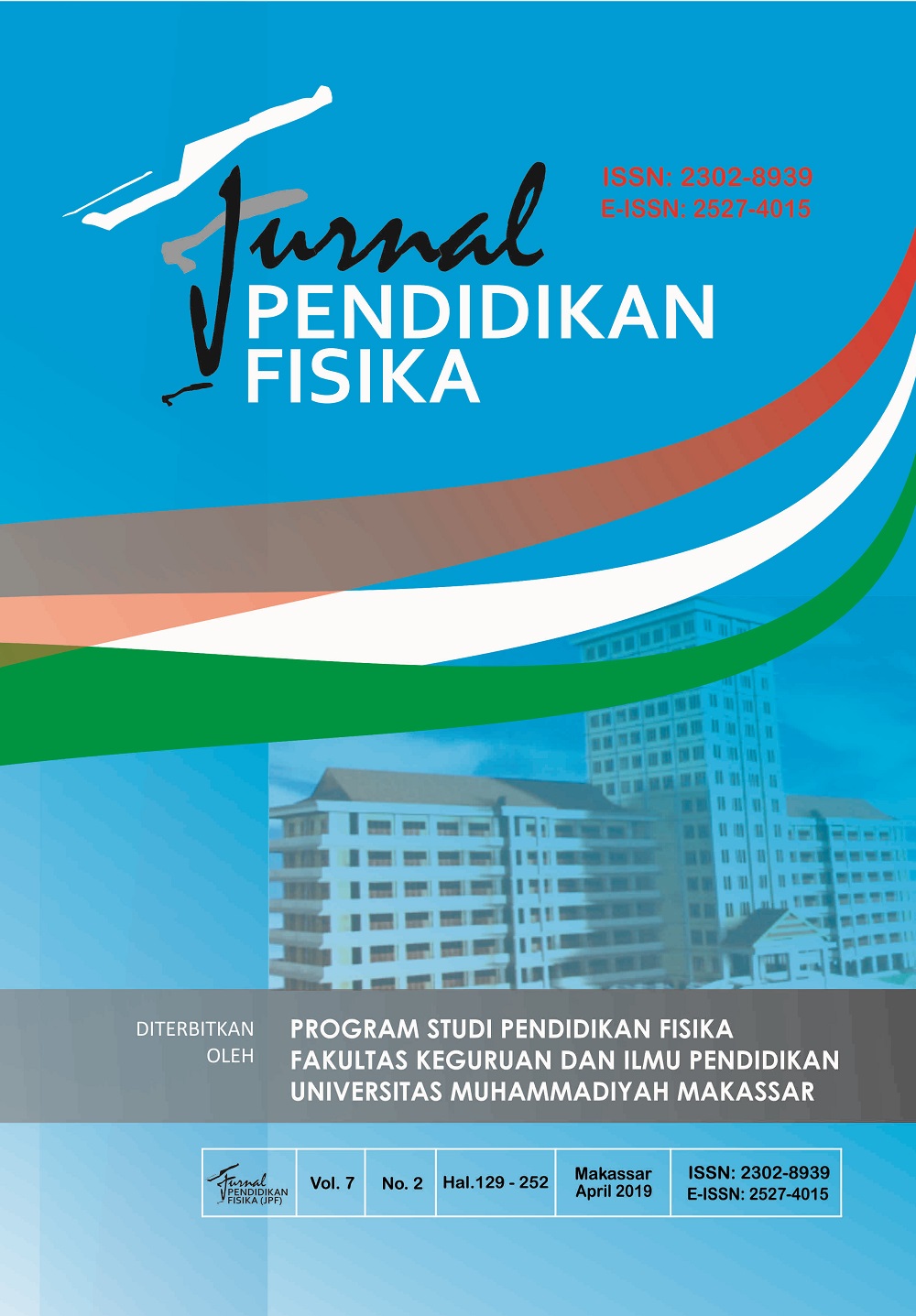The Use of Guided Inquiry Approach to Improve Class X Students’ Physics Problem Solving Skills at SMA 1 Watampone Kabupaten Bone
DOI:
https://doi.org/10.26618/jpf.v7i2.2069Abstrak
This research is a pre-experimental that aims to know: 1) measuring students’ ability of tenth grade SMA Negeri 1 Watampone in solving physics problem that is taught by using guided inquiry approach, 2) measuring the students’ ability in solving physics problem through guided inquiry approach achieve the level of Minimum Passing Standard. The population and all at once as sample in this research is 36 or all of student at tenth grade SMA Negeri 1 Watampone in 2016/2017 academic year. The research design used in this research is One Shot Case Study. The research instrument is the description test in solving physics problem. The result of descriptive analysis shows that the average score of students’ physics achievement after taugh by using guided inquiry approach is 108 and 12 for standard deviation. While the result of inferential analysis shows that students’ ability achieve the minimum passing standard at significance level α = 0,05.
Keywords: guided approach; problem solving skills; Descriptive statistics; inferential statistics
Penelitian ini adalah penelitian pra eksprimen yang bertujuan untuk: (1) mengetahui besarnya kemampuan siswa kelas X SMA Negeri 1 Watampone dalam memecahkan masalah fisika yang diajar dengan menggunakan pendekatan inkuiri terbimbing, (2) mengetahui kemampuan siswa kelas X SMA Negeri 1 Watampone dalam memecahkan masalah fisika melalui pendekatan inkuiri terbimbing mencapai tingkat Kriteria Ketuntasan Minimal. Subjek populasi sekaligus sebagai sampel dalam penelitian ini adalah seluruh siswa kelas X SMA Negeri 1 Watampone tahun pelajaran 2016/2017 sebanyak 36 siswa. Desain Penelitian yang digunakan adalah One Shot Case Study. Instrumen penelitian yang digunakan adalah tes kemampuan memecahkan masalah fisika dalam bentuk tes uraian. Hasil analisis deskriptif menunjukkan skor rata-rata hasil belajar fisika siswa kelas X SMA Negeri 1 Watampone setelah diajar dengan pendekatan inkuiri terbimbing sebesar 108 dan standar deviasi 12. Hasil analisis inferensial menunjukkan bahwa kemampuan siswa kelas X SMA Negeri 1 Watampone dalam memecahkan masalah fisika setelah diajar dengan pendekatan inkuiri terbimbing pada pembelajaran fisika mencapai tingkat Kriteria Ketuntasan Minimal pada taraf nyata α = 0,05.
Kata kunci: pendekatan ikuiri terbimbing; kemampuan memecahkan masalah; statistik deskriptif; statistik inferensial
Referensi
Arikunto, S. 2003. Dasar-Dasar Evaluasi Pendidikan. Jakarta: PT Bumi Aksara
Dahar, Ratna Wilis. 1989. Teori-Teori Belajar. Jakarta: Erlangga.
Hamalik, Oemar. 2001. Proses Belajar Mengajar. Jakarta: Bumi Aksara.
Riduwan. 2009. Skala Pengukuran Variabel-Variabel Penelitian. Bandung: Alfabeta.
Roestiyah. 1998. Strategi Belajar Mengajar. Jakarta: Bina Aksara
Sagala, Syaiful. 2009. Konsep dan Makna Pembelajaran Untuk Membantu Memecahkan Problematika Belajar dan Mengajar. Bandung: Alfabeta.
Sanjaya, Wina. 2008. Perencanaan dan Desain Sistem Pembelajaran. Jakarta: Kencana Prenada Media Group.
Santrock, John W. 2004. Psikologi Pendidikan. Terjemahan oleh Tri Wibowo. 2008. Jakarta: Kencana Prenada Media Group.
Siepman, JP. 1999. “What Is The Science” Journal Of Theoretics. Online (http://www.journalofthetheoretics.com/Editorials/Vol-1/e1-3htm). Diakses 18 Februari 2017.
Sudjana. 2005. Metode Statistika. Bandung: Tarsito.
Sudjana, Nana. 2001. Dasar-Dasar Proses Belajar Mengajar. Bandung: Sinar Baru Algesindo
Sugiyono. 2009. Metode Penelitian Kuantitatif dan Kualitatif dan R&D. Bandung: Alfabeta.
Trianto. 2008. Mendesain Pembelajaran Kontekstual (Contextual Teaching and Learning) di Kelas. Surabaya: Cerdas Pustaka.
Trianto. 2010. Model Pembelajaran Terpadu. Jakarta: Bumi Aksara.
Trihastuti, Singgih dan Yoko Rimy. 2008. Pembelajaran Keterampilan Proses, Inquiry, dan Discovery Learning. Online. (http://umifatmawati.blog.uns.ac.id/2009/07/17/8/). Diakses 23 Februari 2017.
Wetzel, R. David. 2009. “Scientific Inquiry as a Process for Learning”. Online. (http://curriculalessons.suite101.com/article.cfm/scientificinquiry_as_a_process_for_learning). Diakses 18 Februari 2017.
Unduhan
Diterbitkan
Terbitan
Bagian
Lisensi
Copyright:
Authors who publish with this journal agree to the following terms:
1. Authors retain copyright and grant the journal right of first publication with the work simultaneously licensed under a Creative Commons Attribution-ShareAlike 4.0 International License that allows others to share the work with an acknowledgement of the work's authorship and initial publication in this journal.
2. Authors are able to enter into separate, additional contractual arrangements for the non-exclusive distribution of the journal's published version of the work (e.g., post it to an institutional repository or publish it in a book), with an acknowledgement of its initial publication in this journal.
3. Authors are permitted and encouraged to post their work online (e.g., in institutional repositories or on their website) prior to and during the submission process, as it can lead to productive exchanges, as well as earlier and greater citation of published work.
Licence:
Authors are free to:
1. Share: Copy and redistribute the material in any medium or format
2. Adapt: Remix, transform, and build upon the material for any purpose, even commercially.
The licensor cannot revoke these freedoms as long as the authors follow the license terms, which include the following:
1. Attribution: You must give appropriate credit, provide a link to the license, and indicate if changes were made. You may do so in any reasonable manner, but not in any way that suggests the licensor endorses you or your use.
2. ShareAlike: If you remix, transform, or build upon the material, you must distribute your contributions under the same license as the original.
3. No additional restrictions: You may not apply legal terms or technological measures that legally restrict others from doing anything the license permits.
Jurnal Pendidikan Fisika is licensed under a Creative Commons Attribution-ShareAlike 4.0 International License.

